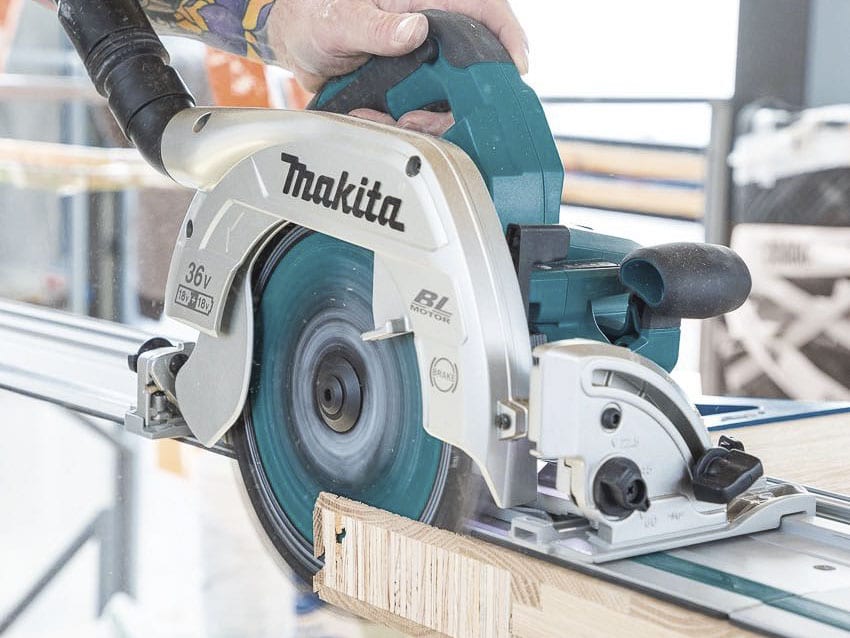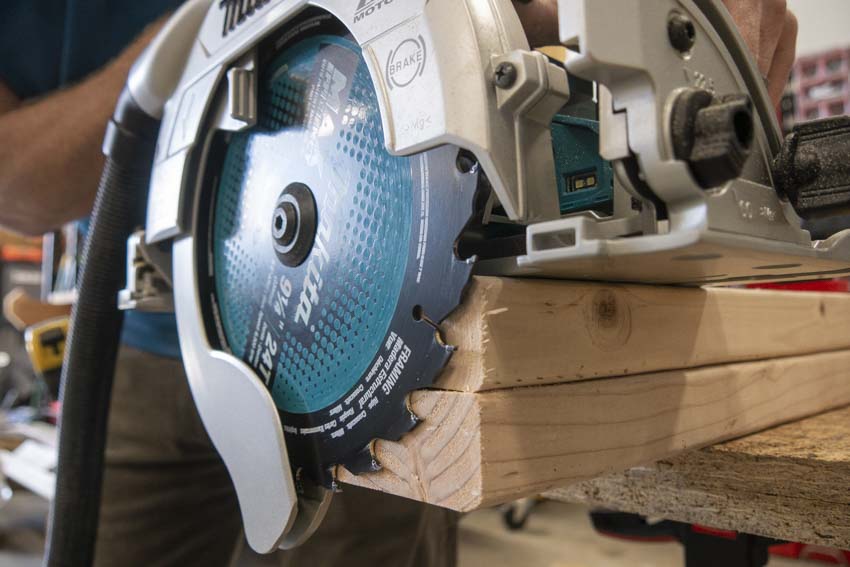Have you ever wondered which way a circular saw spins? Well, my curious friend, you’ve come to the right place! In this article, we’re going to dive into the exciting world of circular saws and explore the direction in which they spin. So, sit tight, grab your safety goggles, and let’s get started!
When it comes to the direction of a circular saw’s spin, there’s a simple answer: clockwise. Yes, you heard it right! Circular saws typically spin in a clockwise direction. But why does this matter, you ask? Well, understanding the direction of the spin can be crucial for a few reasons.
First and foremost, knowing the direction of the spin helps you position the saw correctly for the task at hand. Whether you’re cutting through wood or slicing through metal, aligning the saw properly ensures smooth and precise cuts. So, next time you’re using a circular saw, remember to keep an eye on that clockwise spin!
Now that you’re armed with this knowledge, you can impress your friends with your circular saw expertise. But remember, safety always comes first! Before you embark on any sawing adventure, make sure to wear protective gear and follow proper operating procedures. Now, let’s explore the world of circular saws together!

What Direction Does a Circular Saw Spin? Understanding the Basics of Circular Saw Mechanics
Circular saws are powerful tools commonly used in woodworking, construction, and other industries. They are designed to cut through various materials with precision and ease. If you’re new to using a circular saw, you may be wondering, “What direction does a circular saw spin?” Understanding the direction of rotation is crucial for safe and effective operation. In this article, we’ll delve into the mechanics of circular saws and explore the answer to this important question.
The Anatomy of a Circular Saw: How It Works
Before we can answer the question about the direction of a circular saw’s rotation, let’s first understand the basic anatomy of this versatile tool. A circular saw consists of several key components:
- Blade: The blade is the cutting component of the saw. It typically has sharp teeth on its outer edge for slicing through different materials.
- Motor: The motor is responsible for powering the blade and generating the rotational force.
- Arbor: The arbor is a spindle on which the blade is mounted. It connects the blade to the motor and allows for rotation.
- Guard: The guard is a protective cover that encloses the blade when it’s not in use. It helps prevent accidents and keeps debris from flying out during operation.
- Handle: The handle provides a grip for the user to hold and control the saw.
Now that we have a basic understanding of the components of a circular saw, let’s explore the direction in which it spins.
Understanding Circular Saw Rotation: Clockwise or Counterclockwise?
The direction of rotation for a circular saw depends on whether it’s a right-handed or left-handed saw. Most circular saws are right-handed, which means they rotate in a clockwise direction when viewed from the top. The blade spins in a circular motion, cutting through the material as it moves forward. This clockwise rotation allows for greater control and stability when cutting.
However, it’s important to note that left-handed circular saws do exist, although they are less common. Left-handed saws rotate in a counterclockwise direction when viewed from the top. The choice between a right-handed and left-handed saw depends on personal preference and the specific requirements of the task at hand.
In conclusion, the direction in which a circular saw spins is determined by whether it’s a right-handed or left-handed saw. Most circular saws, including the ones commonly used in woodworking and construction, are right-handed and rotate in a clockwise direction. However, left-handed saws that rotate counterclockwise are also available for those who prefer or require them. Regardless of the direction of rotation, it’s crucial to follow proper safety precautions and use the saw in accordance with the manufacturer’s guidelines.
The Advantages of Right-Handed Circular Saws
Right-handed circular saws, being the more common choice, offer various advantages that make them ideal for most users. Here are three key benefits of using a right-handed circular saw:
1. Ergonomics and Comfort
Right-handed saws are designed to cater to the majority of the population, who are right-handed. The handle and trigger placement of a right-handed saw are optimized for the natural grip and hand movements of right-handed individuals. This ergonomic design ensures a comfortable and secure grip, allowing for better control and precision during cuts.
2. Access to Standard Features
Most circular saw accessories, such as guides, fences, and jigs, are designed to be used with right-handed saws. By opting for a right-handed saw, you’ll have access to a wider range of standard features and accessories, making your woodworking or construction tasks more efficient and convenient.
3. Availability and Affordability
Right-handed circular saws are more readily available and generally more affordable compared to left-handed versions. The popularity and widespread use of right-handed saws mean that they are easier to find in stores or online. Additionally, their higher demand often results in competitive pricing, making them a cost-effective choice for most users.
Tips for Using Circular Saws Safely and Effectively
Now that you understand the basics of circular saw mechanics and the direction in which they spin, let’s explore some tips for using these powerful tools safely and effectively:
1. Wear Personal Protective Equipment (PPE)
Always wear the appropriate personal protective equipment, including safety glasses, ear protection, and gloves. These items will help protect you from flying debris and reduce the risk of injury.
2. Use Proper Blade Selection
Choose the right blade for the specific material you’re cutting. Different blades are designed for different purposes, such as cutting wood, metal, or masonry. Using the correct blade will ensure cleaner cuts and prevent damage to the blade or the saw itself.
3. Maintain a Firm Grip
Hold the saw with a firm grip, using both hands. Make sure your fingers are positioned away from the cutting area. This will provide better control and reduce the risk of accidents.
4. Follow Cutting Guidelines
Follow the manufacturer’s guidelines for proper cutting techniques and safety protocols. This may include using a cutting guide or fence to maintain straight cuts and ensuring the material is properly secured before cutting.
5. Keep the Work Area Clear
Clear the work area of any clutter or obstructions before using the circular saw. This will reduce the risk of tripping or having objects interfere with the cutting process.
6. Disconnect the Power
Before changing the blade or performing any maintenance on the saw, make sure to disconnect the power source to avoid any accidental starting of the machine.
Conclusion
Understanding the direction of a circular saw’s rotation is essential for safe and efficient use. Most circular saws, including the ones commonly used in woodworking and construction, spin in a clockwise direction when viewed from the top. However, left-handed saws that rotate counterclockwise are also available for those who prefer or require them. It’s important to choose the right saw for your needs, follow safety guidelines, and use the tool with caution. By doing so, you can confidently tackle your cutting projects and achieve accurate and clean results.
Key Takeaways: What direction does a circular saw spin?
- Circular saws spin in a clockwise direction when viewed from above.
- The direction of rotation is important for controlling the saw and ensuring proper cutting.
- To maximize safety and cutting efficiency, always check the arrow indicator on the saw blade for the correct rotation direction.
- Most circular saws have a blade rotation lock to prevent accidental rotation changes during use.
- Understanding the direction of rotation helps in setting up and using the saw correctly, avoiding accidents and achieving accurate cuts.
Frequently Asked Questions
Here are some common questions about the direction of rotation for a circular saw.
1. Which direction does a circular saw blade spin?
A circular saw blade spins in a clockwise direction when viewed from the top. This means that the teeth on the blade move from the bottom of the cut towards the top. It’s important to remember this because it determines the way you feed your material into the saw.
When using a circular saw, you want to position the material so that the blade cuts into it with the rotation. This allows the saw to work efficiently and produce clean, accurate cuts. If you feed the material against the spin of the blade, it can cause kickback, increased friction, and potentially unsafe conditions.
2. Can a circular saw blade spin in reverse?
No, a circular saw blade cannot spin in reverse. Circular saws are specifically designed to rotate in one direction only, typically clockwise. The direction of rotation is determined by the motor and gearbox within the saw.
If you need to cut in the opposite direction, you would need to reposition the material or turn the saw around to approach the cut from the other side. Always ensure proper safety precautions and follow the manufacturer’s instructions when using a circular saw.
3. What happens if you install a circular saw blade backward?
If you install a circular saw blade backward, it will not cut properly and can cause damage to both the material and the saw. The teeth of the blade are designed to cut in a specific direction, and installing it backward will result in inefficient and potentially dangerous cutting.
When a circular saw blade is installed correctly, the blade’s teeth are positioned to cut in a specific direction, with the sharp edge of the teeth facing forward. Installing it backward means the dull edge of the teeth will make contact with the material, leading to a poor cut and potential kickback.
4. Why is it important to know the direction of a circular saw’s rotation?
Knowing the direction of a circular saw’s rotation is important for several reasons. First, it ensures that you feed the material into the saw correctly, which is crucial for both safety and cutting efficiency. Feeding the material against the rotation of the blade can cause kickback and result in a rough, inaccurate cut.
Additionally, understanding the direction of rotation helps when making certain types of cuts, such as plunge cuts or bevel cuts. By aligning the material properly with the direction of rotation, you can achieve smooth, precise cuts with your circular saw.
5. Can the direction of a circular saw’s rotation be changed?
No, the direction of a circular saw’s rotation cannot be changed. The direction of rotation is determined by the motor and gearbox design of the saw. Attempting to change the direction of rotation can damage the saw and compromise its safety and functionality.
If you need to cut in a different direction, you will have to reposition the material or use alternative cutting methods. Always consult the manufacturer’s instructions and follow proper safety guidelines when using a circular saw.

HOW TO PUT IN A CIRCULAR SAW BLADE | WHICH WAY SHOULD THE TEETH ON A CIRCULAR SAW FACE?
Summary
So, to sum it up, circular saws spin in a clockwise direction. This is because the teeth of the blade are angled in a specific way, allowing for efficient cutting. It’s important to remember this when using a circular saw to ensure safe and accurate cuts.
In order to control the direction of the saw’s spin, the user can adjust the position of the blade on the saw. By following the manufacturer’s instructions, using protective gear, and practicing proper techniques, anyone can safely operate a circular saw.
